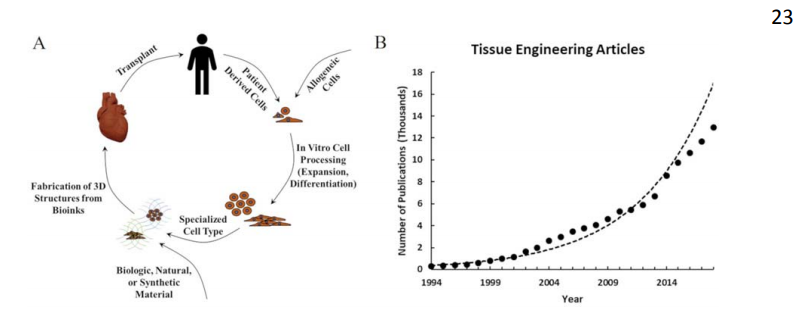3D printing is empowering researchers and inventors from all disciplines to investigate applications that cannot be done with any other technology. As such, with CrAMmed, 3D Printing Industry has started a regular review of the literature available on the topic to deliver the most cutting edge developments to our readers.
In this edition we feature almost 30 research papers and patents exploring micro 3D printing, tissue engineering and composite materials from the likes of Wake Forest Institute for Regenerative Medicine, Argonne National Laboratory, and Siemens. Read on for a whistle-stop tour of additive manufacturing in the world’s laboratories and R&D departments.
A bone (or kidney) to pick with 3D printing
Due to its ability to create complex cell scaffolds that grow to become living tissue, 3D bioprinting is a popular topic in current research literature.
At the University of Sydney, Australia, Dr. Qing Li et al. recently tested the effects of a collagen/bone composite bioink for its ability to encourage the growth of human bone marrow cells (hBMSCs). 3D printed as cell supporting scaffolds, this mixture of materials proved more effective than collagen alone at stimulating bone cell growth. As a result, conclusions state that the bioinks “would be well suited […] to being a porous customized bone substitute,” and that “3D printing scaffolds would be a prospective candidate for clinical application in future.”
Full experimentation and conclusions are published online in Tissue Engineering journal, in the paper titled, “Hydroxyapatite /Collagen 3D printed Scaffolds and their Osteogenic Effects on hBMSCs.”
Also in Tissue Engineering, Part A Tyler Hoffman, Dr. Alireza Khademhosseini, and Dr. Robert S. Langer offer a review of how the field has changed over the past 25 years. “Chasing the Paradigm: Clinical Translation of 25 Years of Tissue Engineering” can be accessed here.

Moving to other organs, and particularly examining the ability to develop kidney tissues, a team from the leading Wake Forest Institute for Regenerative Medicine (WFIRM) recently published a paper in Advanced Healthcare Materials. In this study, Research Fellow Mohamed Ali, Anil Kumar PR, James J. Yoo, Faten Zahran, Anthony Atala and Sang Jin Lee develop a photo crosslinkable bioink suitable for cell based bioprinting that could eventually lead to enhanced tissue formation.
Read more at “A Photo‐Crosslinkable Kidney ECM‐Derived Bioink Accelerates Renal Tissue Formation.”
In another paper from a different team at WFIRM, the institute’s innovative thinkers also describe the necessity for more compatibility between high throughput assays, used for testing, and 3D cell cultures, as created by 3D bioprinting. The discussion, “3D bioprinting for high-throughput screening: Drug screening, disease modeling, and precision medicine applications” can be read in full here.
On training surgeons and understanding cancer
Elsewhere in medical 3D printing, researchers are also investigating the production of anatomical models, (for surgical planning & training), and microfludic devices, (for use in drug screening).
Firstly, in an investigation undertaken by Ostbayerische Technische Hochschule Regensbur and University Hospital Regensburg, Germany, scientists argue that “a 3D printed hand phantom must not only be geometrically but also haptically correct.” As such, the team develop a software workflow to better design the structure of 3D printed anatomical models for use in training. This is discussed further in “Imitating human soft tissue on basis of a dual-material 3D print using a support-filled metamaterial to provide bimanual haptic for a hand surgery training system.”
Moving into drug screening, in the latest research from the University of Minnesota Masonic Cancer Center, a microfluidic vascular tumor structure has been 3D printed allowing researchers to examine the growth of a tumor and test new anticancer medication. The results, “3D Bioprinted In Vitro Metastatic Models via Reconstruction of Tumor Microenvironments,” are published online in Advanced Materials journal.

Understanding metal additive and its in-space application
In a study tipped to be the first of its kind, a Northwestern University and Argonne National Laboratory collaborative has revealed how laser interaction influences powder flow and porosity formation in additive manufacturing. Using high speed x-ray imaging, the team studies the melt effects of a low cost laser on blown powder, with the aim of understanding the underlying physics of laser interaction in directed energy depostion (DED).
“In-situ high-speed X-ray imaging of piezo-driven directed energy deposition additive manufacturing” is published open access in Scientific Reports journal. One of the series of images recorded in Northwestern and Argonne’s study can be seen below.

Meanwhile, at the Chongqing Institute of Green and Intelligent Technology (CIGIT), China, researchers are in hot pursuit of a metal 3D printer than can produce parts in low gravity conditions. Using a wire-based metal feedstock, the team has developed an 8-laser system, and plans to test it in parabolic flight in the near future. Watch out Made In Space.
“Advanced metal-wire laser additive manufacturing in-space” is published by SPIE, and is co-authored by Xueping Ding, Farui Du, Qi Zhang, Guoyu Wang, Shuqian Fan and Xuanming Duan.
Fantastic 3D printed plastic and composites
As the demand for tougher 3D printable resins grows, Georgia Tech and Southwest Jiaotong University researchers have developed a material suitable for direct ink writing (DIW) processes. A shape memory polymer, the high strength resin is also suitable for 4D printing applications. According to the abstract “This UV-assisted DIW 3D printing via a two-stage curing method can broaden the application of 3D printing to fabricate thermoset materials with enhanced toughness and tunable properties for high-performance and functional applications.”
“Fabrication of Tough Epoxy with Shape Memory Effects by UV-assisted Direct-ink Write Printing” is available here.

Also for SLA, North Dakota State University (NDSU) Masters student Patrick Glenn Simpson, has presented a method for the Additive Manufacturing of Short-Fiber Composites.
Further, addressing the need for large volume powder materials for SLS, Case Western Reserve University presents an easy method of combining PA12 with carbon black. Read “3D Printing of a Robust Polyamide‐12‐Carbon Black Composite via Selective Laser Sintering: Thermal and Electrical Conductivity” in Macromolecular Materials and Engineering.
Elsewhere, at Embry-Riddle Aeronautical University (ERAU), scientists are investigating the 3D printability of composite phase-change materials (PSMs). PCMs are a material class capable of absorbing and releasing large amounts of heat/energy, as such, they present a useful alternative to more convetional thermal management applications. At ERAU Thomas Freeman, David Spitzer, Patrick Currier, Virginie Rollin and Sandra Boetcher have conducted a preliminary study into melt temperature, and FFF extrusion of a type of PCM.
SEM pictures and melt temperature measurements of the filament are reported in the Journal of Thermal Science and Engineering Applications as “PCM/HDPE Composite Filament: A First Step Toward Use with 3D Printing for Thermal Management Applications.”

Micro 3D printing – the building blocks of big breaks in medicine and more
Now from the macro to the micro. “A Guiding Framework for Microextrusion Additive Manufacturing” has been described by Edidiong Nseowo Udofia and Wenchao Zhou at the University of Arkansas. In this paper Udofia and Zhou outline a roadmap for successful 3D printing at fine resolution and describes some of the future challenges to the process.
Alternatively, taking the non-extrusion two-photon polymerization (TPP) approach, another team from CIGIT, working with the Technical Institute of Physics and Chemistry, have presented the workings of a new micro 3D printer. A test object 3D printed on this system measures just 1.6 mm, and was made with an accuracy of 10 μm. Read “Additive manufacturing of millimeter-scale micron-accuracy 3D structures” in Front Matter: Volume 10842.
Software completes hardware and materials
Completing the 3D printing trifecta, this last selection of papers focuses on software developments.
Focusing on the structural design of electrical machine cores, a University of Nottingham team has developed a Finite Element Analysis (FEA) based, topology optimization that could be suitable for production via additive manufacturing. The work was conducted in collaboration with Michele Garibaldi, Additive Manufacturing Engineer at Siemens in Belgium. The work can be reviewed online the the Journal of Mechanical Design.
Also using FEA, Qingpeng Chen, Jiwen Chen, Yanhua Zhao, Chen Wang and Xian Chen propose a method of balancing weight to strength ratio in additive manufacturing design. The team from Shandong Jianzhu University using ANSYS Workbench software to carry out their design, and a butterfly motor is used as an example. Read “Lightweight 3D printing traction machine shell nesting cellular topology optimization technology” in the Proceedings of ISBDAI ’18.

New 3D printing patents
New patents relating to 3D printing and additive manufacturing are publish almost on the daily, so it would be better to give you a list of some of the most recent ones that have come to light.
– Filed by Concept Laser GmbH in 2018, and assigned to CL Schutzrechtsverwaltung GmbH: an “Apparatus for additive manufacturing of three-dimensional objects”
– For California based Space Systems Loral: an “Additive Manufactured RF Module”
– And, at Lawrence Livermore National Security, LLC, this “Method for enhanced additive manufacturing” using a High Velocity Laser Accelerated Deposition (HVLAD) subsystem
Are any of the teams mentioned above your Research Team of the Year? Make your nominations now in the 2019 3D Printing Industry Awards.
For more of the latest 3D printing research follow us on Twitter, like us on Facebook and subscribe to our newsletter. Join 3D Printing Jobs now for opportunities in academia.
Featured image shows the Crammed logo over a recolored image of the movement of two powder particles tracked by high speed X-ray at Argonne/Northwestern. Original image via Scientific Reports



